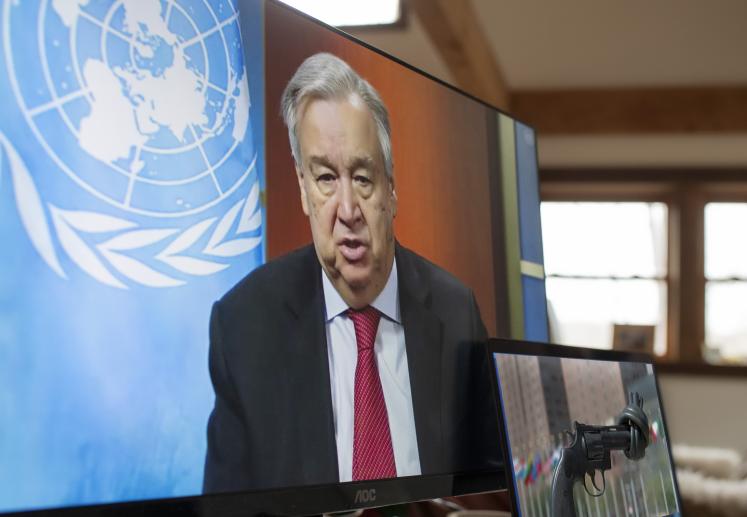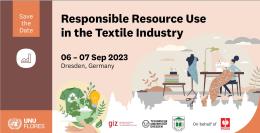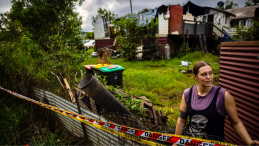COVID-19 is a truly global crisis. This week, Secretary-General António Guterres called it “the biggest challenge for the world since World War Two”. By definition, that would make it the greatest challenge the United Nations has ever faced.
No country can escape either the health dimension of this crisis, or the economic dimension, on its own. As China has recently learned, even countries that control domestic transmission will remain vulnerable to viral resurgence while other countries struggle with COVID-19.
There are only two ways to avoid that risk. The first is to seal your country off from the global economy. If many countries do that, global trade and investment will wither, impoverishing people everywhere, and consigning the world to a kind of perpetual confinement.
The second option is global solidarity and international cooperation. Exit from the crisis will require intergovernmental and public-private coordination on testing and vaccination, travel regimes, economic safety nets, and, eventually, a synchronized rebooting of global trade and markets. This is why, as I argued last week ahead of the G20 Virtual Summit, we desperately need a plan for a coordinated exit.
Yesterday, the UN General Assembly called unanimously for “the United Nations system under the leadership of the United Nations Secretary-General to work with all relevant actors in order to mobilize a coordinated global response.” The mandate was included in the first Resolution the General Assembly has ever adopted virtually, titled “Global Solidarity to fight the coronavirus disease”.
The challenge now for Secretary-General António Guterres is to mobilize that response, and to move Member States quickly from rhetoric to concrete action.
Here are four steps he should consider to make that happen:
1. Broker a global debt holiday
Developed countries have taken unheard of steps in the last two weeks to put their own economies into "hibernation", including measures that effectively nationalize payrolls, corporate debt and in some cases childcare services. A week ago, G20 leaders announced that these unilateral efforts would, together, amount to some USD $5 trillion in domestic stimulus. Going further, the G20 also committed “to do whatever it takes” to minimize the economic damage.
So what will it take? The Secretary-General could start by brokering a temporary global debt holiday — a moratorium on debt repayments and interest — not just for developing countries, but for specific classes of debt globally.
As COVID-19 was taking hold in China, financial sector and other business leaders were gathering at the World Economic Forum (WEF) in Davos, eager to discuss the rise of “stakeholder capitalism”. As WEF's head Klaus Schwab has argued, COVID-19 is a litmus test for stakeholder capitalism. The Secretary-General should put the global financial sector to that test by challenging them to back a global debt holiday.
This should start within the UN family, with relief from the World Bank and International Monetary Fund (IMF).
In the last few weeks, the World Bank and IMF have moved relatively swiftly to provide financing packages to developing countries, addressing both the health and economic consequences of the crisis. The urgency of the situation was viscerally driven home by the death by COVID-19 of a former US Executive Director at the Bank, Caroline Brookins.
Both organizations have, however, also called for debt relief for the world’s 76 poorest countries, to free up fiscal space to fund public health spending in response to the crisis. Developing country debt stocks are now around 193 per cent of their combined GDP. In comparison, they were just over 100 per cent in 2008, when the global financial crisis hit. Around USD $45 trillion in debt repayments are due from these countries by 2024 — USD $2.7 trillion of that by the end of next year.
These calls for debt relief have, so far, largely gone unheeded. As the number one creditor for many developing countries, China has a key leadership role to play here. The Secretary-General could begin by working with the Chinese leadership to explore an agreement on debt relief to developing countries.
But he should not stop there. The debt threat is not limited to developing countries. It also poses a growing test of social and political solidarity between and even within developed countries.
In Europe, pressure for debt relief in countries such as Italy, Spain and Greece is likely to mount, turning fiscal pressures into tests of European solidarity and eurozone governance. The European Central Bank (ECB) has bought time through a EUR €750 billion bond-buying programme. But the push from nine countries for the creation of "coronabonds" — mutualized debt obligations that the ECB could then purchase as part of its stimulus programme—is highlighting traditional EU divisions over fiscal transfers from north to south.
In the US, the municipal bond market is rapidly drying up, as local government bankruptcies threaten. This has massive implications for basic service provision: cities are beginning to furlough large chunks of their workforces. The US has no provision for governmental bankruptcy; insolvent cities and municipal governments will be forced to negotiate with state and federal legislators for relief. Puerto Rico’s experience suggests that will place huge strains on the US multi-level governance arrangements.
So, a first step for the Secretary-General would be to reach out to global financial industry and government leaders, for example through UN Global Compact networks, and broker support for a time-bound moratorium on repayments and a suspension of interest accrual for specific classes of debt across the global financial sector.
This debt holiday would send an unprecedented signal of solidarity to workers, markets and households globally, and buy important breathing room to fashion a longer-term recovery.
2. Cut a deal on Special Drawing Rights (SDRs)
Yet, there is more to the economic side of an exit plan than just debt relief. Developing countries are now staring into a far larger financing abyss. They need not only a debt holiday in order to be able to use the resources they already have available, but also a massive injection of new resources, especially because their traditional sources of revenue are collapsing.
Developing countries stand to lose around USD $800 billion in trade this year. Many emerging economies face significant downturns in commodity and tourism revenues and in remittance income, as well as steep currency pressures and capital flight. Portfolio outflows from developing countries have been twice as great in the month since the virus went global as in the first month of the 2008 global financial crisis.
Poor countries, especially in sub-Saharan Africa, have shrinking fiscal space to pay for public health responses, let alone the kind of economic life-support policies adopted in OECD countries in recent weeks. IMF managing director Kristalina Georgieva has warned that emerging economies would need USD $700 billion in funding even if they used all their foreign exchange reserves. And many of them cannot access international capital markets.
Partly in response to these concerns, earlier this week Secretary-General Guterres released a report on the socioeconomic impacts of the crisis, which his PR team billed, unambitiously, a plan that could “defeat the virus and build a better world”. (Disclosure: I and others at United Nations University provided some drafting minimal inputs to the report.) The report calls for “a large-scale, coordinated and comprehensive multilateral response amounting to at least 10 per cent of global GDP” — roughly USD $8 trillion.
One way to get from the G-20 USD $5 trillion stimulus commitment to this larger injection of liquidity is to unlock IMF SDRs, which can be a near-equivalent to hard cash for low-income countries. In a report earlier this week, UNCTAD, the UN’s trade and development agency, called on the IMF to make USD $1 trillion available through SDRs.
That is not uncontroversial. It will require negotiation among states to agree on such an approach and, in particular, to agree on quotas for allocation of those SDRs.
Yet, as Brookings Fellow and former UN Under-Secretary-General Jean-Marie Guéhenno has pointed out, it is conceivable that such a deal could prove attractive to the US, China, EU and Germany, issuers of key international currencies. It would help ensure stability in international currency markets at a time when domestic spending will generate massive deficits.
But, as of yet, there is no sign of such a deal. With the General Assembly mandate to lead a coordinated response in hand, Secretary-General Guterres could work with IMF Managing Director Georgieva to generate one.
3. Create a global response clearinghouse
Secretary-General Guterres’s report on the socioeconomic impacts of the crisis also presses for “an immediate coordinated health response to suppress transmission and end the pandemic” that “scales up health capacity for testing, tracing, quarantine and treatment, while keeping first responders safe, combined with measures to restrict movement and contact.”
An effective global public health response will require coordination going beyond the remit of the World Health Organization (WHO).
“Countries need to work together to develop a science-based, cooperative approach to allocating scarcer resources on the basis of a truly collective public health needs assessment,” the Secretary-General’s report argues. “Otherwise, key resources will languish unused where they are not needed, and not be available at critical moments where and when they are. This puts us all at risk.”
This will require careful sharing and, as far as possible, coordination of national policies affecting operational response across interlocking policy domains. These would include:
-
The movement of response-critical personnel and goods;
-
Export restrictions on high-demand medical equipment;
-
Lowering tariffs on essential medical equipment such as disinfectants and sanitization products; and,
-
Soon, addressing sanitary, phytosanitary and labour migration disruptions of global agricultural markets and food security.
A UN-convened policy clearinghouse could compile and maintain an up-to-date data set of policies affecting global response coordination across these domains. The UN Secretariat could work with Member States and relevant UN entities — including the Food and Agriculture Organization, International Fund for Agricultural Development, International Civil Aviation Organization, International Labour Organization, International Maritime Organization, UN Sustainable Development Group, World Food Programme, World Health Organization, World Tourism Organization and World Trade Organization — to manage this database, and to answer queries from Member States.
At the moment, clearinghouse mechanisms are springing up organically online, such as the IMF Policy Tracker and the Oxford University Government Response Tracker. Having such a mechanism centrally coordinated by the UN would help ensure transparency, certainty and trust for all governments.
4. Form a global COVID-19 diagnostics, vaccine and therapeutics task force
Finally, the Secretary-General could convene a Global Task Force on COVID-19 diagnostics, vaccines and therapeutic treatments. These are the key tools that will unlock the exit from this crisis. Without them, restrictions on mobility will remain.
The Task Force would bring together key research, industry, financing and regulatory actors, to coordinate and accelerate the process of discovering, financing, manufacturing and distributing these medicines, until the crisis passes.
International efforts to develop a vaccine are currently highly fragmented and even competitive. As the Secretary-General’s report notes, “The world is in urgent need of a common vision and plan of action for leveraging the latest advances in scientific research, emerging technologies and new data sources in the fight against COVID-19.”
Regulators have a key role to play in unblocking barriers to effective cross-border information-sharing and cooperation. There is a need for careful coordination of clinical testing regimes, to ensure both speed of development and safety. And industry and financial actors have a key role to play in figuring out how to equitably bring to bear all necessary resources.
The Task Force could begin by agreeing to a set of principles to govern the process of Research & Development for the vaccine and therapeutics, including ensuring commitment to equitable access.
Maintaining global solidarity
The final challenge for the Secretary-General is to generate and maintain solidarity between States, and prevent a zero-sum mentality taking hold. This has been a powerful and central focus of his public communication in recent weeks.
It has also been a focus of UN actions to date. The UN has set up a trust fund to support low and medium-income countries in the fight, alongside calls for $USD 2 billion in humanitarian funding to deal with the looming humanitarian crisis, and a separate fund to support frontline medical response.
The unanimous support of the General Assembly for UN leadership of a coordinated response sends a powerful signal of support. Even the title of the Resolution underscores the Secretary-General’s message of "Global Solidarity". Yet there are signs of geopolitical division emerging.
Two resolutions were in fact considered by the General Assembly. The successful one was put forward by Ghana, Indonesia, Liechtenstein, Norway, Switzerland, and Singapore, but ended up with 188 co-sponsors. It was eventually endorsed by consensus under silence procedure.
The other was put forward by Russia, the Central African Republic, Cuba, Nicaragua and Venezuela, and had the support of some 23 others. It proved controversial with the Western European and Other Group, in part because it included language committing states “not to apply any unilateral coercive measures undertaken without the mandate of the Security Council” — a reference to US and EU sanctions. Several states, including the US, UK, Georgia and Ukraine, objected to the text, and it was not adopted.
The Great Powers have proven similarly unable to cooperate in the Security Council. It has to date remained notably silent during the crisis, unable even to come out in support of the Secretary-General’s call for a global ceasefire. Although belligerents often ignore the Security Council’s calls for ceasefires, its support would lend weight to the Secretary-General’s call. As it is, fighting continues unabated in many conflict theatres, including Afghanistan, Libya, Mali, Syria and Yemen.
The blockage in the Security Council? Disputes between the US and China over wording around the geographic origin of the pandemic, and between Russia and other Council members over working methods to hold virtual meetings. The Council is expected to consider two Resolutions on the crisis next week: one put forward by France, and the other put forward by the 10 elected members. If it cannot muster a coherent response, it will only underscore what Richard Gowan, UN Director at International Crisis Group, has called “a signal of shambolic disunity”. That will help no one.
Whatever the result in the Security Council, the General Assembly has set the Secretary-General a clear task: to work with Member States to identify a path out of the crisis, and lead the coordination needed to execute it.
The weeks ahead will tell if the UN is up to this challenge, by the Secretary-General’s own reckoning, its greatest ever.
Suggested citation: Dr James Cockayne., "States Back a UN-Led International Response to COVID-19: Now What?," UNU-CPR (blog), 2020-04-03, https://unu.edu/cpr/blog-post/states-back-un-led-international-response-covid-19-now-what.



